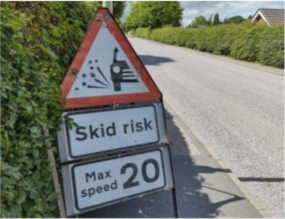
See more information about surface dressing:
- What surface dressing is
- Why surface dressing works are undertaken
- How we assess roads for surface dressing
- Surface dressing works notifications
- Follow-up precautions to surface dressing works
- Usability of newly surface dressed roads
- Further information about surface dressing
What surface dressing is
Surface Dressing is the application of one or more alternating layers of bitumen and stone chippings to the clean, dry surface of a road.
Surface Dressing work is carried out during the summer months as the weather needs to be warm and dry to ensure that embedment of the chippings into the road surface is maximised. If it is too cold, chippings will not embed into the surface and if it is too hot the bitumen will not hold the chippings in place. If the existing road surface is wet before application or if heavy rain is forecast shortly after application, surface dressing will be ineffective. If wet weather is forecast up to 24 hours before surface dressing is due to commence, the work will be rescheduled for a later date within this period.
There will be no road markings on the road following the surface dressing treatment, and there is likely to be loose stone on the surface causing reduced grip levels. An advisory 20mph speed limit will be put in place until the road markings are replaced, and all loose stone has been cleared. Motorcyclists and cyclists should take particular care during and shortly after surface dressing and if possible use an alternative route.
Why surface dressing works are undertaken
Surface dressing remains the most cost-effective solution in the road maintenance industry and as the process is quick, does not include the removal and disposal of existing surface materials, nor the reintroduction of new bituminous material it is considered more ‘environmentally friendly’ as compared to traditional ‘plane and surface’ techniques. It is suitable for most roads and traffic conditions and is quickly applied, minimising time on site and reducing delays to traffic.
It is a preventative maintenance treatment with the process sealing the surface (preventing potholes forming) and improving the skidding properties significantly. It prolongs the life of the road for up to 10 years and is a key maintenance treatment for all Highway Authorities helping them to maintain their roads both structurally and in a safe manner.
How we assess roads for surface dressing
Roads are assessed to ensure they are suitable for this treatment, taking account of the age and condition of the existing road surface. Contractors design the chipping size and specification based on the classification, volume of traffic and speed – single dressing, dual dressing, racked in, binder type and rate. If the road has deteriorated beyond what we believe is suitable for surface dressing, then dressing will not be used. The roads selected are pre patched and potholes repaired before the dressing is applied as necessary.
Surface dressing works notifications
Residents, businesses, etc. affected by surface dressing will receive a guidance leaflet from our contractor in advance of the work. On-street information boards will be erected in advance on signposts or lighting columns giving the dates of when the work is to be carried out. If the work dates need to be changed, the dates on the information boards will be changed accordingly.
It is often necessary to close roads completely for the duration of the surface dressing work. If this is the case, information will be provided.
If you require access to or egress from your property whilst surface dressing work is being carried out on your road, please make contact with a member of the contractor's site team who will be able to assist. Access for emergency services vehicles is maintained at all times during the work.
Follow-up precautions to surface dressing works
The roads are swept after the initial application, within 48 hrs and then again within 14 days. Advanced warning signs are placed on site and diversion routes signed if required. Advisory speed limits of 20 mph are also signed.
Usability of newly surface dressed roads
As soon as the traffic management has been removed the road can be walked on.
Please take care when walking on new surface dressing, as loose stone can reduce grip underfoot. If walking on the surface very shortly after it has been laid, please check footwear before entering buildings in case any material has stuck to shoes.
Where cyclists are unable to find a convenient alternative route and can’t avoid riding on the newly laid surface, extra care should be taken, and cyclists are advised to ride in the wheel tracks created by cars where there will be less loose stone.
Please also keep an eye on pets (particularly cats) during the works. Whilst every effort is made to keep animals clear of the works, they can wander on to the wet material.
Further information about surface dressing
The case for surface dressing - Road Emulsion Association (REA) and Road Surface Treatment Association (RSTA) have joined forces to explain why surface dressing is the solution to reducing potholes. You can find out more from RSTA’s website.


